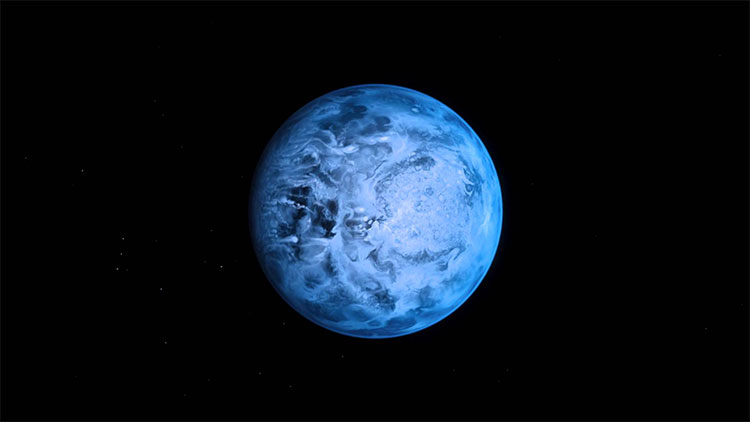Extreme weather on outer space planets
Glass rain, super typhoon or dizzying temperature change are three of the special phenomena that occur on outer planets.
Jupiter is about 600 million km from Earth. On this planet, super typhoon has been operating for over 350 years.
This super typhoon cannot move north or south. The reason is that the upper and lower air currents limit its direction. However, the Great Red Spot can freely move to the sides. This super bag was so big that it could fit 3 Earths, but now it was smaller. With a wind speed of more than 400km / h, surely the Big Red Stain will make you want to stay away.
The next planet has special rains.

Exotic planet HD 189733b.
Exotic planet does not rain water but melted . Therefore, covering the umbrella normally does not work. The planet is 63 light-years away from Earth and is in the form of a 'hot Jupiter' , meaning it is about the same size as Jupiter but closer to the star than the distance between Earth and the Sun.
The temperature on this planet can be higher than 900 degrees Celsius, heating silicate particles on the atmosphere and creating melting glass rain.
Unusual rain also occurs in some other places in the universe.
For example, on the stub star HOPS-68 there is crystal rain . The small green crystals of ovilin mineral fall to HOPS-68 from the surrounding gas cloud. This crystal needs a temperature equivalent to lava to form, so it is possible that they form near the surface of the star, then disperse into the surrounding gas cloud and fall back like sparkling particles.
If you hate the dizzying temperature change, you should stay away from the next planet.
Planet HD 80606b is also in the form of 'hot Jupiter'. The temperature of this place can be doubled in just 6 hours. Specifically, the temperature may vary from 500 degrees C to more than 1200 degrees Celsius. The cause is due to the special elliptical orbit of the planet.
HD 80606b takes 111 days to spin around the host star. When it comes to its most hostess, it receives 800 times more light at its farthest point. If you step outside and see the Sun 800 times brighter, you will probably die the day because the heat is too great.
- Unknown mystery about planets outside the solar system
- Dead planets may be signaling in outer space
- The harsh summers await humanity
- Discover mechanisms to help plants survive in extreme weather
- For the first time, we can see livestream images from outer space
- Big cities in Asia will be 'unprecedented extreme' weather
- Controlling the weather as you want?
- Discover the first 4 peripheral planets in 2012
- Why are astronauts forbidden to drink in outer space?
- Strange weather patterns on extraterrestrial planets
- The culprit caused an unusually hot and cold weather phenomenon
- Journey more than two decades to explore the outer planet
 Van Allen's belt and evidence that the Apollo 11 mission to the Moon was myth
Van Allen's belt and evidence that the Apollo 11 mission to the Moon was myth The levels of civilization in the universe (Kardashev scale)
The levels of civilization in the universe (Kardashev scale) Today Mars, the sun and the Earth are aligned
Today Mars, the sun and the Earth are aligned The Amazon owner announced a secret plan to build a space base for thousands of people
The Amazon owner announced a secret plan to build a space base for thousands of people NASA's 'Ninth Planet' Shows Signs of Being Friendly to Life
NASA's 'Ninth Planet' Shows Signs of Being Friendly to Life  Which planet is the oldest and youngest in the Solar System?
Which planet is the oldest and youngest in the Solar System?  Breakthrough discovery of planet with more water than Earth
Breakthrough discovery of planet with more water than Earth  How would humans die when visiting other planets?
How would humans die when visiting other planets?  Habitable planet appeared next to Earth, but met with disaster
Habitable planet appeared next to Earth, but met with disaster  Chinese spacecraft discovers mysterious cubes on other planets
Chinese spacecraft discovers mysterious cubes on other planets 